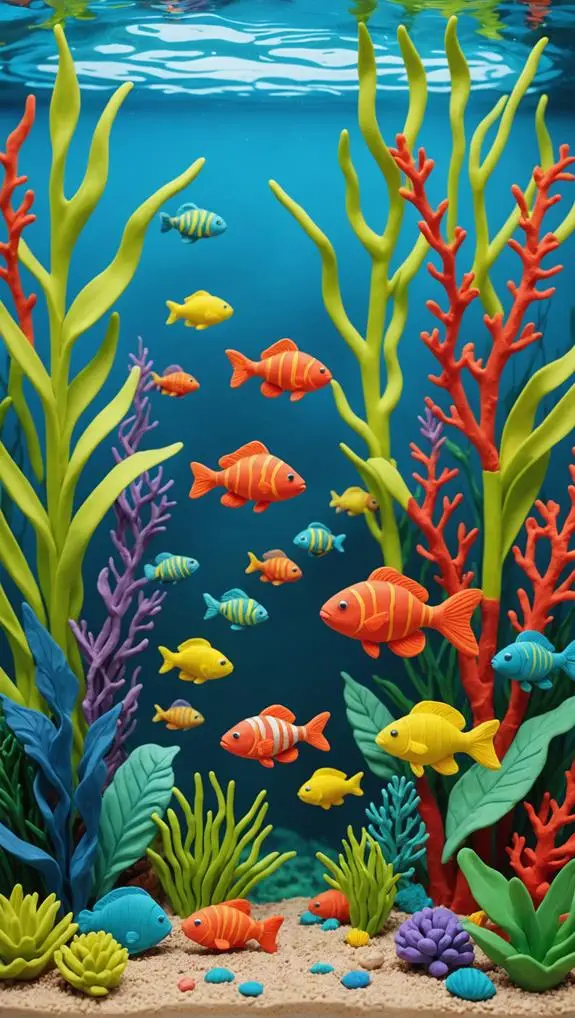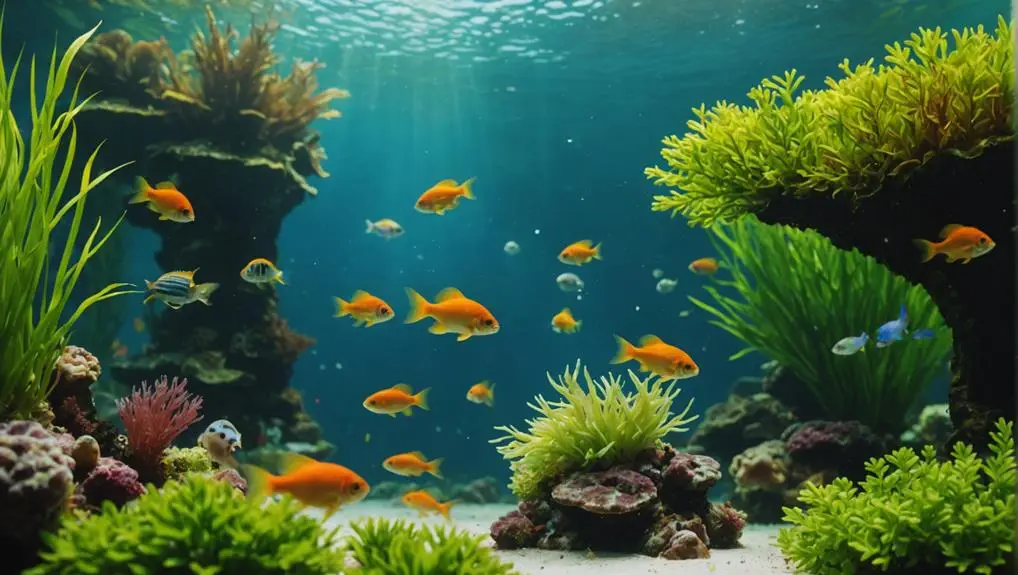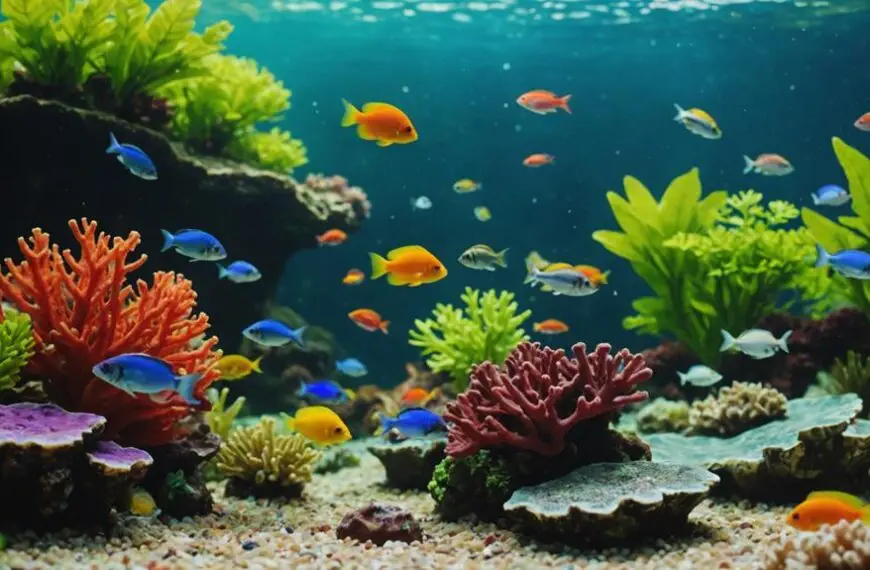Recognizing overfeeding signs in your aquarium fish is super important for keeping them healthy and happy. Look out for bloating and lethargy—if your fish are hanging at the bottom like they're waiting for a meal train that's late, it's time to reconsider their feeding schedule. Uneaten food floating around is a big red flag, too. Also, pay attention to water quality; cloudy water means trouble. Fish should polish off their meals in just a few minutes. If you notice any of these signs, now's the time to change things up. There's plenty more to learn about keeping your aquatic pals thriving!
Contents
Signs of Overfeeding Fish
Recognizing the signs of overfeeding fish is essential for maintaining a healthy aquarium. When you notice uneaten food floating on the surface or settling in the substrate, it's a clear indicator that you might be giving your fish too much to munch on. This uneaten food can lead to poor water quality, which isn't just bad for the fish; it's like serving a five-star meal in a dirty kitchen! Excess waste from overfeeding can also raise ammonia levels, creating toxic conditions that threaten your aquatic life, highlighting the importance of effective water quality management.
You might also see signs of overfeeding in your fish, like visible bloating or swollen abdomens, sometimes accompanied by scales that stick out like little pinecones.
And if the water starts looking cloudy or you find excessive algae growth, it's time to reconsider those feeding habits.
Moreover, keep an eye on ammonia levels. Overfeeding often raises ammonia, which can harm your fish and mess with the tank's overall vibe. Lethargic fish that hang out at the bottom instead of swimming around happily might be telling you they've had one too many snacks.
Common Symptoms to Observe
When monitoring your aquarium, it's important to watch for common symptoms that signal overfeeding. One of the first things you might notice is a swollen abdomen on your fish, which can indicate digestive distress from too much food.
Regularly testing your water quality is crucial since monitoring parameters can help you identify issues early. You should also keep an eye out for uneaten food floating on the surface or settling at the bottom of the tank. If you see this, it's a clear sign that you might be overfeeding.
Another symptom is cloudy water, which often comes with increased algae growth. This can be a result of leftover food breaking down and overwhelming your aquarium water.
You may also notice your fish becoming lethargic, showing less activity than usual. This can reflect stress or discomfort due to excessive food intake.
Consequences of Overfeeding

Overfeeding your aquarium fish can lead to serious consequences that affect their health and the overall ecosystem of your tank. When you toss in too much food, you'll likely find uneaten food sinking to the bottom. This uneaten food can rot, causing high ammonia levels in the water, which should always be at 0 ppm to prevent toxicity.
High ammonia is no joke; it can stress your fish and even affect their gill function. You might notice your fish acting lethargic or behaving oddly.
Additionally, that decaying food creates a feast for harmful bacteria, leading to cloudy water and poor water quality. This not only compromises fish health but can also trigger illness. If you're not careful, you might even see the dreaded fatty liver disease in certain species, like African cichlids, which can really hinder their overall vitality.
Plus, all that extra waste means you'll need to change the water more often to keep your fish happy and healthy.
Importance of Feeding Guidelines
When it comes to feeding your fish, sticking to proper guidelines is key for their health and happiness.
You want to serve up just the right amount—enough for them to munch in about 4-5 minutes—so you avoid turning your tank into a buffet of uneaten food.
Plus, knowing the specific needs of your fish and adjusting how often you feed them can make a world of difference, keeping those little swimmers fit and happy!
Optimal Portion Sizes
Understanding optimal portion sizes is crucial for maintaining a healthy aquarium environment. You want to make sure your fish are happy and healthy, and that starts with how much you feed them.
A good rule of thumb is to give them only what they can eat within 2-3 minutes. This helps prevent uneaten food from piling up, which can lead to water quality issues.
Aim for about 2% of a fish's body weight in food daily, but remember, this can vary based on their species, activity level, and tank setup. Keep an eye on their feeding habits; if you notice uneaten food lingering, it's a sign you might be overfeeding.
Smaller amounts more frequently can work wonders, especially for species that like to graze throughout the day. Regularly removing any uneaten food not only keeps the tank clean but reinforces those optimal portion sizes.
After all, you want to ensure your little swimmers are content without turning into little food critics! So, adjust as needed, and you'll create a thriving environment for your aquatic pals.
Species-Specific Nutritional Needs
Every fish species has its own unique dietary needs, making it crucial to follow specific feeding guidelines. You wouldn't serve a steak to a rabbit, right? Similarly, your fish require tailored diets to thrive.
Some species, like carnivorous fish, need high-protein meals, while others, like herbivores, flourish on plant-based options. Ignoring these differences can lead to overfeeding, which creates excess waste and can harm your aquarium's water quality.
The recommended daily intake generally suggests feeding fish about 2-3% of their body weight, but this can vary based on size and activity levels. Keep an eye on your fish's feeding habits. For instance, bettas might nibble differently than the schooling tetras, so adjust portions accordingly.
If you're feeding protein-rich diets to sensitive fish like African cichlids, you risk them developing fatty liver disease.
To cater to their nutritional needs, mix things up with flakes, pellets, and frozen foods. This variety helps meet their dietary requirements and keeps them healthy.
Feeding Frequency Recommendations
To ensure your fish thrive, it's vital to establish a consistent feeding schedule. Most fish do best with a feeding frequency of once or twice a day.
You want to feed your fish only the amount of food they can gobble up in about 2-3 minutes. This helps prevent overfeeding your fish, which can lead to health issues like obesity.
Tailoring the amount of food to match the size and species of your fish is also important. Some fish are like little vacuum cleaners, while others nibble delicately. Observing their eating habits can help you adjust how much and how often you feed them.
Don't forget to give your fish a break! Fasting them once a week can help prevent obesity and digestive problems, keeping them happy and healthy.
Think of it as a little fishy spa day.
Preventing Overfeeding Practices

Preventing overfeeding in your aquarium is essential for maintaining a healthy environment for your fish. You want to make sure you're feeding your fish just the right amount, so aim to provide food they can consume in about 2-3 minutes. It's not a buffet, after all!
You might wonder how much to feed them, and sticking to a consistent schedule of once or twice a day can help. Don't forget to remove uneaten food promptly to keep the water clean—nobody likes a messy tank!
To further enhance their well-being, consider a diet specifically suited to your fish species. Different fish have unique needs, and variety is the spice of life!
Adding scavenger species, like bottom feeders, can also help clean up any leftover bits. Oh, and remember, overfeeding leads to excess waste, which can harm your fish and your water quality.
Lastly, consider giving your fish a break with a fasting day each week. It might sound cruel, but trust me, their digestive systems will thank you!
With these practices, your fish will thrive, and you'll feel like a true aquarium hero!
Monitoring Fish Behavior
Keeping an eye on your fish's behavior offers valuable insights into their health and feeding habits. During feeding time, observe how quickly your fish munch on their meals. Ideally, they should finish within 2-5 minutes. If there are leftovers floating around, it's a sign you might be overfeeding them.
Watch for changes in fish behavior, too. If they're swimming sluggishly or hiding at the bottom of the tank, this could indicate stress or health issues linked to overfeeding. You might also notice increased squabbles among your fish as they compete for food—another hint that you need to adjust your feeding practices.
Don't forget to monitor fish for physical signs like bloating or protruding scales. These can alert you to overfeeding and potential health complications.
On the flip side, if your fish show little interest in their meals, nibbling instead of devouring, they might just be too full or stressed, possibly due to water quality.
Managing Water Quality

How can you ensure your aquarium stays healthy for your fish? One of the most important aspects is managing water quality, especially if you've been overfeeding. When fish don't eat all their food, it decays, leading to increased ammonia and nitrite levels. These toxic substances can stress your fish or, worse, lead to their death. Yikes!
To keep things in check, make water quality testing a regular part of your routine. Check for ammonia, nitrites, and nitrates to catch any issues early on.
Also, don't forget about those uneaten morsels lurking at the bottom of your tank. They can cause high nutrient levels, resulting in cloudy water and pesky algae blooms.
Implementing routine water changes—about 20-30% weekly—can work wonders. It refreshes the water and helps dilute harmful substances.
Plus, a cleaning regimen with gravel vacuuming and filter maintenance will keep your fish happy and healthy. Remember, you're not just a fish keeper; you're a fish hero!
Tips for Proper Feeding
Feeding your fish properly can make all the difference in keeping them happy and healthy.
You'll want to stick to a consistent schedule, giving them 1-2 meals a day, and only offering what they can gobble up in about 2-5 minutes—no fish should be going to bed with leftovers!
Feeding Frequency Guidelines
Establishing a proper feeding routine is crucial for the health and well-being of your aquarium fish. Aim to feed them 1-2 times daily, offering only small amounts of fish food that they can gobble up in about 2-3 minutes. This minimizes uneaten food and helps maintain water quality, which is vital for keeping your fish happy and healthy.
As you feed, keep an eye on your fish's behavior. If you notice leftover food floating around, it's a sign you might be overfeeding. Adjust the amounts accordingly to prevent stress on both your fish and the tank environment.
Creating a consistent feeding schedule is essential, as it reduces the likelihood of overfeeding. Consider giving your fish a fasting day once or twice a week. It's like a spa day for them, enhancing digestion and combating obesity in certain species.
Lastly, always choose high-quality, species-specific fish food. This not only meets their dietary needs but also helps cut down on excess waste.
With these feeding frequency guidelines, you'll be well on your way to keeping your aquatic friends thriving!
Portion Control Techniques
When it comes to portion control for your aquarium fish, it's essential to strike the right balance to ensure their health. You want to feed your fish just enough food so they can gobble it up within 2-3 minutes. This way, you avoid those uneaten bits that can pollute the water. A good rule of thumb is to offer about 2% of their body weight in food per feeding.
Establish a regular feeding schedule, ideally 1-2 times a day. Consider giving your fish a day or two off each week to aid digestion; think of it as a little spa day for them!
While you're feeding, watch your fish closely. If they're leaving food behind, it's a sign you're overdoing it. Adjust those portions accordingly!
Don't forget to mix it up! Use sinking pellets for bottom dwellers and floating flakes for the swimmers at the top. Variety keeps your fish happy and healthy.
Frequently Asked Questions
How to Tell if Fish Are Overfed?
To tell if your fish are overfed, observe their behavior closely. Adjust your feeding schedule, diversify food types, maintain proper tank maintenance, and monitor water quality to ensure optimal fish health and prevent overfeeding issues.
What Happens if You Overfeed Aquarium Fish?
Imagine your vibrant aquarium; overfeeding disrupts its harmony. Fish digestion falters, water quality declines, and their behavior shifts. Increased disease susceptibility and poor feeding frequency can upset the delicate balance, harming your aquatic friends.
How Do You Know if Fish Aren't Eating Enough?
You'll notice changes in fish behavior, like lethargy or increased foraging. Adjust your feeding schedule to meet their dietary needs, maintain tank cleanliness, and monitor water quality to support optimal fish health.
How Do You Treat Overfed Fish?
Think of your fish as delicate dancers. To treat overfed fish, adjust feeding frequency, monitor fish behavior, maintain water quality, perform tank maintenance, and diversify their diet. Prioritize health monitoring to ensure their graceful survival.
Final Thoughts
So, keep an eye on your fish and their feeding habits. You don't want them to turn into swimming balloons! Remember, a little goes a long way when it comes to food. Stick to feeding guidelines, and your fish will thrive, keeping your aquarium vibrant and lively. By monitoring their behavior and water quality, you'll create a happy underwater world. A few simple practices can make all the difference. Happy fishkeeping!












